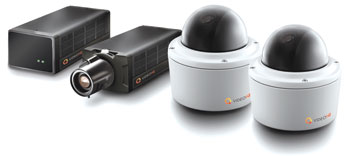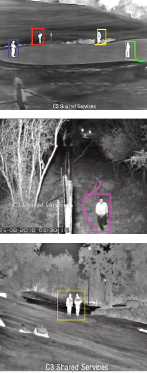

It’s not too long ago that video analytics was touted to be the answer to every security problem, from perimeter and intrusion detection, through to left object detection and whatever you could do with an image. Reality, unfortunately got in the way and it turns out it’s not that easy to analyse video and solve the world’s problems.
Today we still have many companies offering motion detection and the like, but their success is limited with more false alarms being raised than threats detected. Some would say that analytics is a dismal failure.
On the other hand, while we know that the big promises of video analytics never panned out, there are real benefits in certain analytical applications that do deliver real value. Hi-Tech Security Solutions asked some people who should be in the know to tell us more about the real state of the video analytics market.
We spoke to Brendon Cowley, business development director for C3 Shared Services, Stephan Beckmann, product marketing manager, EMEA for Tyco Security Products, and Andrew Page Wood, MD of VideoIQ Africa.
Hi-Tech Security Solutions: How mature is the video analytics market today? Which analytical applications are really proving their worth? Which still have a way to go?
Brendon Cowley: The video analytics market is not fully mature yet and still growing, there are security (protecting sites, detecting intruders etc.) applications and commercial applications (people counting, presence analysis, age and gender detection, etc). While security analytics is mature and has a clear value and ROI, commercial analytic is still at its early stages and its value is not clear yet.
Stephan Beckmann: In the early days of analytics, the market was burdened with the perception that analytics can solve everything, when at the end of the day customers ended up with an overall disappointing experience. We are gradually moving past that, but the expectation in the market is still that analytics is a system that you can set up and leave to run without additional interaction.
In reality, analytics are a tool that can be used by customers where settings are fine-tuned and adapted to fit new and changing scenarios and environments, such as seasonal adjustments for weather, foliage or changing light conditions. With these expectations, analytics have really excelled in areas like retail, with analytics such as recognising when someone is lingering in front of a particular merchandising display or determining when the queue of people waiting at the checkout exceeds more than three customers.
Analytics have also excelled as a data gathering tool that, when combined with other systems such as retail point of sale systems can produce information useful for forensic investigations as well as for general operational issues.

Andrew Page Wood: I think it’s important to understand what we mean by analytics, because so many companies refer to analytics with respect to many products. Analytics, to me, is the ability for software to identify and classify objects in the field of view of a camera and deliver real-time information on their behaviour while ignoring any background, noise or irrelevant pixels in a video scene. This is always easier indoors, like in a store, but becomes a different game completely when the camera is outdoors in varying weather conditions and especially in low light situations.
Applications that can give real-time information on object behaviour are invaluable in two areas:
1. Crime prevention through early warning at any building or site. Core to this is the art of eliminating false alarms created by motion analysis or VMD (video motion detection). Many suppliers now provide this and it almost always ends up being more dangerous than having nothing at all.
2. Accurate people behaviour analysis in retail or for health and safety.

HSS: Which companies are developing the better analytics applications – the VMS vendors, camera manufacturers or independent companies focusing on analytics – and why?
Brendon Cowley: Originally the best analytics were developed by dedicated analytics companies; they employed teams of algorithm developers that worked on inventing and perfecting the algorithms for years. As the market evolved, most independent analytic companies didn’t survive. Today analytics is considered a feature, an important one, but still a feature, and therefore can’t justify the existence of an independent company. Some independent analytic companies were merged with existing VMS / cameras manufacturers and as a division they still provide the best analytics.
Stephan Beckmann: From an integrator and end-user perspective, there are only so many companies that actually develop the analytics themselves. Camera manufacturers, for example, typically will rely on third-party developers for onboard analytics, while many VMS manufacturers also deploy third-party analytics from one vendor or support integration with variety of analytics providers.
From our perspective, we made investments early on to bring the development of video analytics in-house, which allowed us to engineer our video technology to best utilise the built-in analytics.
Andrew Page Wood: The best companies to do analytics are those that understand and can afford to invest in it. VideoIQ has invested in this only. It’s an arduous and complicated background technology that does not have any short cuts and requires literally thousands and thousands of hours of programming. There are only around five or six companies in the world that are doing this successfully and they only do analytics and can demonstrably deliver real value.
VideoIQ’s analytics software compares video images to over 400 000 templates in its database (which is updated regularly) to definitively identify and differentiate between people, vehicles and objects as well as what they are doing. This allows the company to offer video analytics that eliminates almost all false alarms.

HSS: Some say the trend is to run analytics on the edge (in the camera). Is this a trend of the future or is it already happening? Are cameras able to handle the additional processing load?
Brendon Cowley: Edge based analytics have been around for years. The advantage of edge processing is reduced bandwidth, reduced resource consumption of the central server, reliability (there is no single point of action that may fail, but distributed processing on the edge), better accuracy etc.
Some dedicated cameras/encoders can handle the necessary processing and provide not only good camera functionalities, but also additional analytic processing.
DVTEL (powered by ioimage) has cameras and encoders that do edge processing as well as acting as a camera/IP encoder. The company has many successful installations all over the world with more than 10 years of field proven analytic deployments. C3 has numerous successful sites in South Africa using DVTel ioimage.
Stephan Beckmann: In general, the level of analytics running on the edge in a camera is still an algorithm of lower complexity because of the processing power of the camera. However, as the cost of this computing power continues to decline, the capabilities of cameras will grow exponentially to handle a wide range of analytics at the camera level.
End-users should be aware that their particular application should dictate the complexity of the analytics required at the edge, not the processing power of the camera. In some scenarios, edge analytics are used to perform the initial analysis of a scene, and then an operator can step in and perform a more detailed inspection to determine if further action or response is needed.
For example, our Illustra line of HD IP cameras is equipped with face detection which finds faces in the scene and improves the quality of the image around the face while reducing the bit rate in the rest of the scene. This further reduces bandwidth and storage costs.
Andrew Page Wood: Yes, it’s key to keep the processing (and storage if possible) on the edge. This requires a design into the camera and working directly off the sensor, that’s the best option.
Your best analytics are done on the raw video. IP cameras will compress images before sending them to a server and this loses some of the video data. Today’s network infrastructure (based on TCP/IP) is also not designed for high-quality video.
Putting it simply, if you want accurate analytics you need to use the most pixels. This is also why high definition and multi-megapixel cameras deliver better analytics, more pixels to analyse means better results.
HSS: Where will companies get the best results from running analytics: on the camera or on the server? And why?
Brendon Cowley: The answer depends on the customer’s expectations and configuration, both server- and edge-based analytics have advantages and disadvantages.
* With edge-based analytics the video is not fetched constantly to the central server. Therefore it consumes less bandwidth and less server resources. It’s also more reliable as if the server fails the analytics is still stable (not dependent on a single point of operation).
* Server-based analytics is more scalable, channels can be added/reduced with a click of a button without having to mount anything in the field. It’s also more flexible when wanting to analyse IP video from different IP cameras/sources (no dependency of specific hardware).
Stephan Beckmann: Again, this depends on the needs of the application. Server based solutions use more processing power and can be more accurate in the results because of the strength behind the analytics. Whereas the camera or edge based analytics are more of a simple decision, such as determining whether something in a scene needs to be dealt with more in depth. Perimeter protection focused analytic solutions tend to rely more on server-based analytics because of environmental differences due to weather conditions.
Server-based architectures become more important where people are recording video only when motion is detected. This leaves many variables dependent on the individual camera. One camera may have a particular sensitivity while another brand or model could be less sensitive, generating inconsistent results.
Andrew Page Wood: As noted above, however, historically analytics is done on the camera, but this is a direct correlation with the quality/speed/design of the network. As networks improve and more bandwidth becomes available and cheaper, server analytics will be an option. Of course, in a site with hundreds of HD cameras, in-camera analytics may be the only option, as the bandwidth required for all that HD video would be enormous.
We should also remember that the edge does not have to refer to the camera. Retail stores, for example, could have analytics servers in each store that do the work so that footage doesn’t have to be transmitted to a central location for analysis.
HSS: Are analytical apps that can be bought and loaded onto a camera (like cellphone apps) a reality, will it find broad acceptance or is it only a nice idea?
Brendon Cowley: Commercial analytics may work as an app, security (or more precisely perimeter protection analytics) has to be performed on a video signal that comes from a stable camera that is installed on a specific height and angle, therefore only applicable for fixed cameras with decent video quality (and not for mobile phones).
Stephan Beckmann: Generally these apps would be preconfigured on the manufacturer or distributor level and not something that would come into play from the integrator or end user perspective.
Andrew Page Wood: Eventually this will happen as the market moves to general acceptance and analytics become de facto. VideoIQ has adopted a similar model where its software is available without licensing or royalty fees etc. It’s simple to download the latest software and update your VideoIQ device without any additional fees or hassles.
HSS: How does the user make sure the analytics he’s being sold will work as well in real-world situations as in the vendor’s demo? What questions should the user ask?
Brendon Cowley: Analytic quality is defined by its performance – probability of detection (POD) and false alarm rate (FAR). Naturally the user expects POD close to 100% and FAR close to 0%. In order not to fail and to ensure buying the best analytics, the user has to test it first in the field or at least buy a reliable product that has been deployed and tested in the actual conditions for an extended period.
Stephan Beckmann: For any analytics project, our suggestion is always to have a trial setup with a few cameras and relevant scenes, or for an existing surveillance installation to enable the analytics licences and give the system a test run. The analytics within our victor/VideoEdge platform are designed for this purpose, and can retroactively analyse, for example, a week of existing video footage with analytics applied.
The important thing to remember is that analytics are a tool that humans use, and at least at this point, are not intended to replace the human who makes decisions based on the information the system provides. The success of an analytics program is to know your application, know your environment and know exactly what information you want the system to deliver.
Andrew Page Wood: The following questions are critical:
1. Can the analytics distinguish between a human, a vehicle and other objects and automatically classify them in a database?
2. Can the analytics eliminate false alarms or positives during trying conditions – rain, shadows, birds, camera shake or leaves – especially at night?
3. What do they cost? Most software given away free will not have the above capabilities?
4. Can the software learn its background and thus understand how to eliminate noise?
5. Is it painful to set up? Does it need to be regularly calibrated and does it need maintenance and resetting periodically – or is recalibration automatic?
Contacts
C3 Shared Services, Brendon Cowley, 0861 2377 00, www.c3ss.com
Tyco Security Products, Ernest Mallett, +27 (0)82 566 5274, www.tycosecurityproducts.com
VideoIQ Africa, Andrew Page Wood, +27 (0)861 VIDEOIQ, www.videoiq.co.za
| Email: | [email protected] |
| www: | www.johnsoncontrols.com/security |
| Articles: | More information and articles about Johnson Controls - (Tyco Security Products) |
| Tel: | +27 11 312 2041 |
| Email: | [email protected] |
| www: | www.c3ss.com |
| Articles: | More information and articles about C3 Shared Services |

© Technews Publishing (Pty) Ltd. | All Rights Reserved.